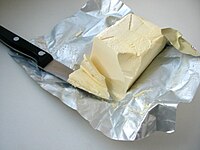
Photo from wikipedia
Brain is a lipid-rich tissue, and fatty acids (FAs) play a crucial role in brain function, including neuronal cell growth and development. This study used GC-MS to survey all detectable… Click to show full abstract
Brain is a lipid-rich tissue, and fatty acids (FAs) play a crucial role in brain function, including neuronal cell growth and development. This study used GC-MS to survey all detectable FAs in the human parietal cortex (Brodmann area 7). These FAs were accurately quantified in 27 cognitively normal age-matched controls, 16 cases of moderate Alzheimer’s disease (AD), 30 severe AD, and 14 dementia with Lewy bodies (DLB). A total of 24 FA species were identified. Multiple comparison procedures, using stepdown permutation tests, noted higher levels of 13 FAs but the majority of changes were in moderate AD and DLB, rather than severe AD. Subjects with moderate AD and DLB pathology exhibited significantly higher levels of a number of FAs (13 FAs and 12 FAs, respectively). These included nervonic, lignoceric, cis-13,16-docosadienoic, arachidonic, cis-11,14,17-eicosatrienoic, erucic, behenic, α-linolenic, stearic, oleic, cis-10-heptanoic, and palmitic acids. The similarities between moderate AD and DLB were quite striking—arachidic acid was the only FA which was higher in moderate AD than control, and was not similarly affected in DLB. Furthermore, there were no significant differences between moderate AD and DLB. The associations between each FA and a number of variables, including diagnosis, age, gender, Aβ plaque load, tau load, and frontal tissue pH, were also investigated. To conclude, the development of AD or DLB pathology affects brain FA composition but, intriguingly, moderate AD neuropathology impacts this to a much greater extent. Post-mortem delay is a potential confounding factor, but the findings here suggest that there could be a more dynamic metabolic response in the earlier stages of the disease pathology.
Journal Title: Metabolites
Year Published: 2018
Link to full text (if available)
Share on Social Media: Sign Up to like & get
recommendations!